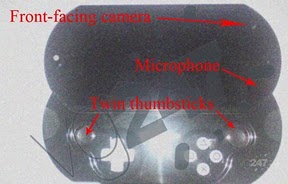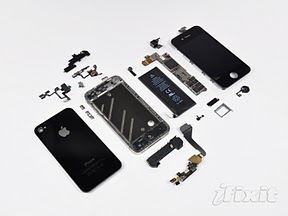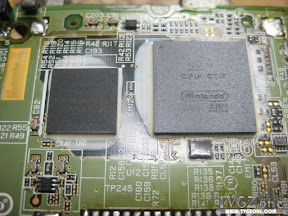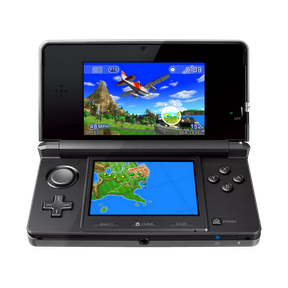This post has not been edited by the GamesBeat staff. Opinions by GamesBeat community writers do not necessarily reflect those of the staff.
 You may not realize this, but people have an exaggerated sense of how much portable devices cost to build. This has never been more clear than in the wake of the 3DS’ $250 price point reveal and the run up to the PSP2’s announcement. The rumored specifications for the PSP2 are impressive. We know for certain it will have dual analog sticks, a multitouch OLED screen, and at least a 3G cellular option.
You may not realize this, but people have an exaggerated sense of how much portable devices cost to build. This has never been more clear than in the wake of the 3DS’ $250 price point reveal and the run up to the PSP2’s announcement. The rumored specifications for the PSP2 are impressive. We know for certain it will have dual analog sticks, a multitouch OLED screen, and at least a 3G cellular option.
Other reports suggest a second, rear touch pad, two cameras, a quad core ARM Cortex-9 CPU, a quad core PowerVR-based GPU, 512MB of RAM, 16GBs of flash storage, and a 960 by 544 resolution display. The Internet has responded to these rumors with a certain amount of pricing anxiety. Many are a predicting a retail price of over $400.
It’s not hard to see why. If you look at the prices of smart phones like the iPhone 4 or the Samsung Galaxy S, both of which run about $600 without a service contract, you have to wonder how Sony could afford to sell a much more powerful device for less.
Well, the dirty little secret of smart phones is they don’t actually cost as much to build as you might suspect. An iSuppli estimate last summer placed the cost of building an iPhone 4 at about $188. That figure isn’t exact, but it's a reasonable approximation based on known prices for comparable components.
 Knowing that, it becomes easier to understand Apple’s unprecedented profitability over the last couple years. This should also bring some perspective to the debate over the PSP2’s potential price. Very large mark ups have been a common practice in the smart-phone market for some time. As such, you can’t look at the MSRP of a fancy new touch-screen handset and assume it must have cost nearly that much to make.
Knowing that, it becomes easier to understand Apple’s unprecedented profitability over the last couple years. This should also bring some perspective to the debate over the PSP2’s potential price. Very large mark ups have been a common practice in the smart-phone market for some time. As such, you can’t look at the MSRP of a fancy new touch-screen handset and assume it must have cost nearly that much to make.
Perhaps this will allay apocalyptic fears of an obscenely priced PSP2. It’s not hard to imagine that Sony, with their extensive experience and resources (and an additional year of Moore’s Law beyond the iPhone estimate), could break even on a very powerful PSP2 priced at $250. The only question is whether Sony will take Nintendo's 3DS price announcement as a license to charge more.
That would be unfortunate. Based on its likely manufacturing cost, the 3DS seems to have a pretty severe mark up. The processor, memory, and GPU are only slight upgrades over the original, six-year-old PSP, and all of the other components are commodity parts. Even the main selling point, a autostereoscopic 3D screen, is merely a common 800 by 480 LCD panel with an inexpensive parallax barrier pasted on.
Although uncommon, there are already cell phones and digital cameras that feature similar screens on the market. This rarity has led some to assume such screens are extremely expensive to produce. Manufacturers consider it a premium feature, however, not because the screen costs significantly more to make, but because you literally need two cameras in one device to capture 3D photos. In fact, you can add the same kind of autostereoscopic 3D the 3DS uses to any iPhone 3GS for $10 with a simple accessory screen.
 The total cost of manufacturing a 3DS is very likely half of the $250 MSRP, maybe less. Whether or not a consumer finds the 3D screen desirable, it is difficult to justify the $250 price tag when you are getting so much less than that in terms of actual hardware capabilities. It’s unfortunate that Nintendo made the choices they did with the 3DS architecture when they could have easily used an off-the-shelf, single chip CPU/GPU from Samsung, Qualcomm, Texas Instruments, or nVidia that would have been far more powerful and still allowed for a comfortable profit margin at $250. Alternatively, the 3DS as it is now would have been far more palatable at a $150 to $180 price range.
The total cost of manufacturing a 3DS is very likely half of the $250 MSRP, maybe less. Whether or not a consumer finds the 3D screen desirable, it is difficult to justify the $250 price tag when you are getting so much less than that in terms of actual hardware capabilities. It’s unfortunate that Nintendo made the choices they did with the 3DS architecture when they could have easily used an off-the-shelf, single chip CPU/GPU from Samsung, Qualcomm, Texas Instruments, or nVidia that would have been far more powerful and still allowed for a comfortable profit margin at $250. Alternatively, the 3DS as it is now would have been far more palatable at a $150 to $180 price range.
The competition will be very interesting to watch if the price delta between the PSP2 and the 3DS is small or nonexistent. Sony is set to announce the PSP2 officially in Japan on Thursday (which works out to around Wednesday at 10 p.m. PST). It remains to be seen if this will include any announcement about price.
PSP2’s best chance seems to be as a best-in-class, jack-of-all-trades device. It has all the hardware needed to support the simple, touch-based gaming popularized by the iPhone; augmented reality and motion- and tilt-controlled games; music and video playback; apps for Netflix, Hulu, MLB.tv, eBooks, and Marvel Comics; streaming services like Last.fm and Pandora; messaging via email; Twitter, Facebook, and IM; video and audio conferencing with Skype; and a full-featured, touch-driven web browser.
Couple that with all the standard buttons and sticks you expect from PlayStation and the possibility of new versions of Uncharted, Final Fantasy, Monster Hunter, and Metal Gear Solid with top-of-the-line graphics, and the PSP2 could be extremely compelling. It will be all the more so should it go head to head with the 3DS on price.
 Nintendo, as they have been for the last six years, seems content to trust that their latest innovation will catch on well enough to excuse the large markup on their hardware. Unfortunately for them, a significant backlash against 3D in general has cropped up since they revealed the 3DS at E3 last year. Press sentiment has already started to trend against them sharply since their more recent demo events in Japan and New York.
Nintendo, as they have been for the last six years, seems content to trust that their latest innovation will catch on well enough to excuse the large markup on their hardware. Unfortunately for them, a significant backlash against 3D in general has cropped up since they revealed the 3DS at E3 last year. Press sentiment has already started to trend against them sharply since their more recent demo events in Japan and New York.
Last year, it seemed obvious that a PSP successor would be the odd man out between a kid-friendly portable with a 3D gimmick and the soaring popularity of the iPhone and iPod Touch. But as the bad news has piled up around the 3DS — from a disappointing battery life to a higher than expected price to a tepid launch lineup filled with ports and remakes — it is starting to look more and more like the 3DS is the proverbial cheese that stands alone.
